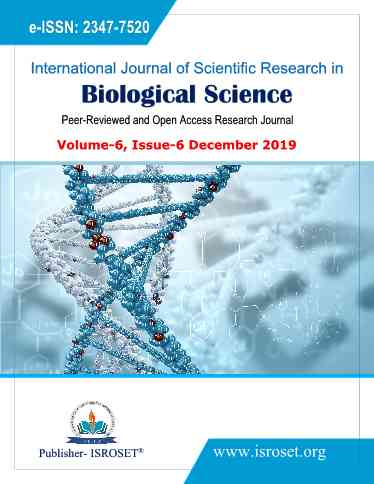Role of Pseudomonas Flourescens on Lead Phytoremediation and Recovery of Adverse Effects in Sansevieria Roxburghiana Plant under Hydroponic Studies
Keywords:
S.roxburghiana, Pseudomonas flourescens, Phytoremediation, Bioconcentration factorAbstract
Phytoremediative potential of Sansevieria roxburghianawas studied in association with siderophore producing bacteria Pseudomonas flourescens in synthetic medium supplemented with different concentrations of lead (40, 80, 120 and 160 mg/L)over aperiod of 30 daysalong with control.Thechlorophyll content decreasedindicatingincreased production of reactive oxygen species effecting photosynthetic activity, this was confirmed by increased malondialdehyde content. The highest concentrations of Pb 6.1 mg g-1 and 26.4 mg g–1 were accumulated in shoots and roots of S.roxburghianagrown on Pb-rich synthetic medium inoculated with Pseudomonas flourescenscompared with uninoculated plants4.2 mg g–1 and 20.23 mg g–1. In S.roxburghianabioconcentration factor (BCF) increased with increase in lead concentration (P<0.05) beforePseudomonas flourescensinoculation and after inoculation BCF showed increase upto 160mg/L and reduced upon increasing concentration of metal.Decrease in biomass with increase in Pd concentration at 40 mg and 80 mgis observed and decreased gradually. Translocation factor (TF) increased at 40 mg, 80 mg but not at 120 mg, 160 mg concentrations without Pseudomonas flourescens and is also not significant with addition of Pseudomonas at all concentrations.The tolerance index showed increase at 40,80 concentrations and low at 120,160 mg concentrations even with inoculation of Pseudomonas flourescens. From the results it is revealed that theS.roxburghianaalong with Pseudomonas flourescens can contribute for more accumulation and high degradative potential towards lead.
References
Jing Yan-de, HE Zhen-li, Yang Xiao-e. “Role of soil rhizobacteria in phytoremediation of heavy metal contaminated soils”, J Zhejiang UnivSci, Vol. 8, Issue. 3, pp. 192, 2007.
Glick B.R., Grichko V.P., “Amelioration of flooding stress by ACC deaminase-containing plant growth-promoting bacteria”, Plant PhysiolBiochem, Vol. 39:11, 2010.
Patil BR, Mugeraya G. “Bioremediation of heavy metals and waste water treatment using leaves and latex of calotropis procera”,. Vol. 2, pp. 34-39, 2013.
Miller Marvin J. “Siderophores (microbial iron chelators) and siderophore-drug conjugates (new methods for microbially selective drug delivery)”, University of Notre Dame, http://www.nd.edu/~mmiller1/page2.html. Vol. 4, pp. 62-66, 2008.
Hider R.C., Kong X. "Chemistry and biology of siderophores", Nat. Prod. Rep. Vol. 27, pp. 637-657, 2010.
Cornelis P., Andrews S.C. “Iron Uptake and Homeostasis in Microorganisms”, Caister Academic Press. ISBN 978-1-904455-65-3. 2010.
Imsande J, “Iron, sulfur, and chlorophyll deficiencies: a need for an integrative approach in plant physiology”, Physiol Plant, Vol. 103, pp. 139, 1998.
Qaiser S, Saleemi AR, Ahmad MM. “Heavy metal uptake by agro based waste materials”, Electron J Biotechnol, Vol. 10, pp. 409–416, 2007. doi: 10.2225/vol10-issue3-fulltext-12.
Abdul-Sada K . H. “A resistance study of Pseudomonas aeruginosa to heavy metals”, Basrah J Vet Res, Vol. 8, pp. 52–60, 2009. doi: 10.33762/bvetr.2009.56874
Trapet Pauline., Laure Avoscan., AgnèsKlinguer., StéphaniePateyron., Sylvie Citerne., Christian Chervin., Sylvie Mazurier., Philippe Lemanceau., David Wendehenne and AngéliqueBesson-Bard. “The Pseudomonas fluorescens siderophore pyoverdine weakens Arabidopsis thaliana defense in favour of growth in iron-deficient conditions”, Plant Physiol. pp.01537, 2015.
Walker E. L., Connolly E. L. "Time to pump iron: iron-deficiency-signaling mechanisms of higher plants",. Current Opinion in Plant Biology, Vol. 11, pp. 530–535, 2008.
Chase M.W., Reveal J.L., Fay M.F. “A subfamilial classification for the expanded asparagalean families Amaryllidaceae, Asparagaceae and Xanthorrhoeaceae”, Botanical Journal of the Linnean Society, Vol. 161, Issue. 2, pp. 132–136, 2009.
Kumar G.H, Kumari J.P. “Heavy Metal Lead Influative Toxicity and Its Assessment in Phytoremediating Plants — A Review”, 2015. doi: 10.1007/s11270-015-2547-7
Arnon D.I. “Copper enzymes in isolated chloroplasts, polyphenoloxidase in Beta vulgaris”, Plant Physiol, Vol. 24, pp. 1-2, 1949.
Harborne JB. “Phytochemical methods, guiding the modern way to analyze plant.”, Penerbit ITB. Bandung. Indonesia. 1987.
Heath R.L., Packer L. “Photoperoxidation in isolated chloroplasts.Arch. Biochem. Biophysics”, Vol. 125, pp. 189-198, 1968.
Petriccione M., Di Patre D., Ferrante P., Papa S., Bartoli G., Fioretto A., Scortichini M.V. “Effects of Pseudomonas fluorescens seed bioinoculation on heavy metal accumulation for mirabilis jalapa phytoextraction in Smelter-contaminated soil”, Water Air Soil Pollut, Vol. 224, pp. 1645, 2013.
Geoffrey Michael Gadd. “Biosorption: critical review of scientific rationale, environmental importance and significance for pollution treatment”, jctb, Vol. 10, Issue. 6, pp. 1002, 1999.
Farinati S, Dal Corso G, Bona E, Corbella M, Lampis S, Cecconi D, Polati R, Berta G, Vallini G., Furini L. “A: Proteomic analysis of Arabidopsis halleri shoots in response to the heavy metals cadmium and zinc and rhizosphere microorganisms”, Proteomics, Vol. 9, pp. 4837, 2009.
Wang, Y.T., Changsong X. “Factors affecting chromium reduction in pure cultures of Bacteria”, Water Res, Vol. 29, pp. 2467, 1995.
Nichols T.D., Wolf D.C., Rogers H.B., Beyrouty C.A., Reynolds C.M. “Rhizosphere microbial populations in contaminated soil”, Water, Air and Soil Pollution, 95:165, 1997.
Wiltse C.C., Rooney W.L., Chen Z., Schwab A.P., Banks M.K., “Greenhouse evaluation of agronomic and crude oil-phytoremediation potential among alfalfa genotypes", Journal of Environmental Quality, 27:169-172, 1998.
Downloads
Published
How to Cite
Issue
Section
License

This work is licensed under a Creative Commons Attribution 4.0 International License.
Authors contributing to this journal agree to publish their articles under the Creative Commons Attribution 4.0 International License, allowing third parties to share their work (copy, distribute, transmit) and to adapt it, under the condition that the authors are given credit and that in the event of reuse or distribution, the terms of this license are made clear.







